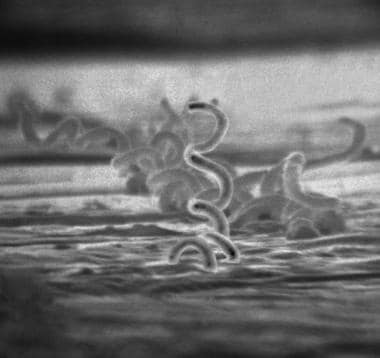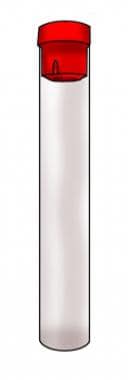
Syphilis detection tests are serologic tests used to screen for and confirm infection with Treponema pallidum.

--> Electron micrograph of Treponema pallidum.
The reference range for syphilis detection tests reflects an absence of treponemal exposure, as follows:
Venereal Disease Research Laboratory (VDRL) test: Nonreactive Rapid plasma reagin (RPR): Nonreactive Fluorescent treponemal antibody absorption test (FTA-ABS): Nonreactive T pallidum particle agglutination (TP-PA): Nonreactive Enzyme immunoassay (EIA): NonreactiveThe results of syphilis detection tests need to be placed in the context of the patient’s clinical presentation; primary syphilis may not yet show seroconversion, and levels in patients with latent or tertiary syphilis may decline to the point of nonreactivity.
Table 1. Sensitivity of Syphilis Tests (Open Table in a new window)
Primary Syphilis
Secondary Syphilis
Latent Syphilis
Tertiary Syphilis
Data not yet available
Data not yet available
The specificity rates of syphilis tests are as follows:
RPR/VDRL: 85%-99% FTA-ABS/TP-PA/EIA: 96%All positive RPR and VDRL test results should prompt follow-up with FTA-ABS or TP-PA. Biologic false-positive results are defined as a positive RPR/VDRL result with a negative FTA-ABS/TP-PA result and are due to reactivity of autoantibodies to the cardiolipin-lecithin-cholesterol reagent present in the nontreponemal tests. Generally, these present with a low titer (≤1:8) in patients with the following: [1]
Autoimmune disease (systemic lupus erythematosus, antiphospholipid antibody syndrome) Intravenous drug use HIV infection Treponemal infection (yaws, pinta, bejel) Advanced age (10% in patients >70 years) Malignancy Tuberculosis Viral disease (hepatitis, mononucleosis) Hansen diseaseLumbar puncture VDRL to detect CNS involvement should be performed in the following: [1]
Patients with positive serum serology findings and evidence of neurologic or ophthalmologic involvement
Patients with HIV infection who also have syphilis of unknown duration or more than one year duration
Nontreponemal (RPR/VDRL) titers can be used to monitor treatment response. Successful treatment is associated with a 4-fold or two-tube decline in titer (ie, from 1:32 to 1:8) 6 months after therapy for primary or secondary syphilis and 1 year after therapy for latent syphilis. RPR and VDRL titers are not interchangeable or convertible, so it is important to use consistent testing with a single method to monitor disease activity. The treponemal (FTA-ABS/TP-PA) tests remain positive for the life of the patient regardless of therapy, and titers are not reported. [2, 3]
Specimen: 5-10 mL of venous blood collected for this test
Collection method: Routine venipuncture; no preparation required in advance of the blood draw
Specimen container: Red-top Vacutainer tube (see image below)
Rejection: Hemolyzed, lipemic, and grossly contaminated samples invalidate testing
Storage: Sample should be refrigerated

--> Red-top Vacutainer tube.
Syphilis detection tests are serologic tests used to screen for and confirm infection with T pallidum. These tests have largely replaced direct visualization of spirochetes owing to greater ease of testing, less reliance on observer experience, and less-expensive equipment. The tests are categorized into two serologies: nontreponemal tests and the treponemal tests.
A survey by Davis and Gaynor of state and local US public health laboratories (with 81 out of 105 participating [77.1%]) found that in 2016, the respondents performed a total of 1,235,037 Treponema pallidum tests. [4]
Nontreponemal tests include the Venereal Disease Research Laboratory (VDRL) test and the rapid plasma reagin (RPR) test. They were the earliest developed, with the VDRL in use since its development in 1906. These tests are used to detect immunoglobulin G (IgG) and immunoglobulin M (IgM) antibodies against a cardiolipin-lecithin-cholesterol antigen, which are formed indirectly during infection with T pallidum. Because these antibodies are not specific for T pallidum, false-positive results on nontreponemal tests are frequently encountered in numerous physiologic and pathologic conditions (see Interpretation). Positive nontreponemal test findings should be confirmed with treponemal serology. Apart from their use in screening and diagnosis, nontreponemal antibody titers are used to measure disease activity, as higher titers are positively correlated with bacterial load.
Treponemal tests include fluorescent treponemal antibody absorption test (FTA-ABS), T pallidum particle agglutination test (TP-PA), chemiluminescence immunoassay (CIA), and enzyme immunoassay (EIA). These are used to test for the presence of antibody to specific components of treponemal organisms and therefore have lower false-positive rates. This higher specificity makes them ideal as confirmatory tests after a less-expensive nontreponemal test shows reactivity. However, because subspecies of T pallidum cause ailments distinct from syphilis, these tests will show seropositivity in patients with yaws, pinta, and endemic/nonvenereal syphilis (bejel). [5, 1, 6, 7, 8, 9, 10]
EIA and CIA are treponemal tests used by some laboratories in a testing method referred to as reverse testing. Unlike traditional testing, which uses a nontreponemal test as the initial screening, in reverse testing, the EIA/CIA test is performed first and, if positive, reflex tested with a quantitative RPR/VDRL. Discordant results after reflex testing (ie, positive CIA/EIA findings with a nonreactive RPR/VDRL result) require further testing with TP-PA. Because of confusion about discordant results, the CDC still recommends traditional testing, although EIA/CIA is gaining popularity because of easier automation, and it may be the method of choice in the future. [11]
A study by Fakile et al indicated that a point-of-care rapid syphilis treponemal (RST) test is an effective syphilis screening tool in an emergency department setting when laboratory testing is unavailable or an immediate result is required. The investigators found that the RST test detected syphilis in 76.9% of patients who were RPR and TP-PA reactive. [12]
In patients with HIV infection, serology is an effective screening method for concomitant syphilis infection. Generally, higher serum titers are seen in patients with HIV, however, unpredictable responses including delayed seroconversion and false negatives have rarely been reported. In patients with negative serology but strong clinical suspicion, dark field microscopy of lesions can be used to establish a diagnosis. [13, 14]